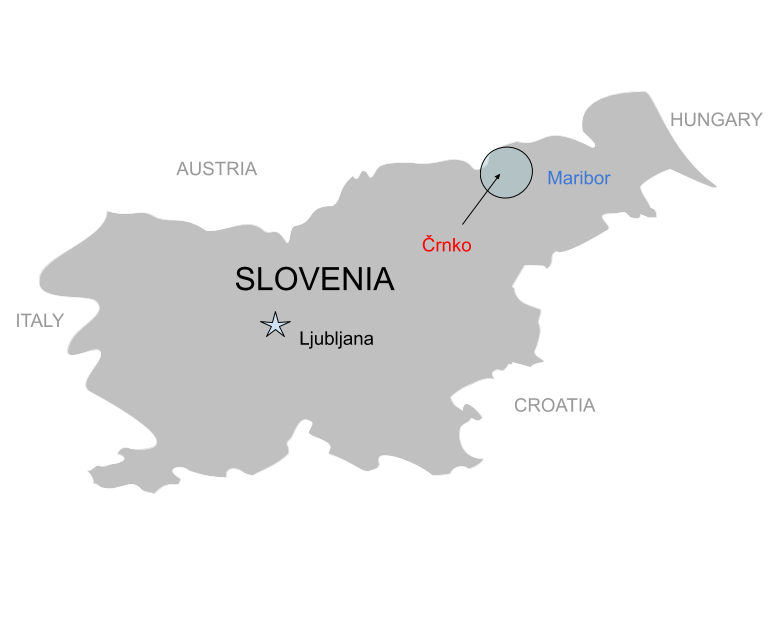2018 Črnko Jareninčan
Štajerska, Slovenia

The Črnko farm is located on the eastern side of Slovenia, north of Maribor and just south of the Austrian border. It is a breath taking environment of endless rolling green hills lined with vineyards that stretch the length of the horizon. Until 1918 this area was known as Lower Styria (formally Austria) and had been for many centuries. Grapes have also been cultivated here for over 2,000 years in addition to famed aromatic hop fields and ethereal pumpkin seed oil; a real treat with the local wines. The rich agricultural diversity of these Slovenian Hills owes itself to fertile soils and the unique convergence of Continental, Alpine and Mediterranean climates. In large part it is the balance between these climates that make the wines of Slovenia so regional and so interesting. The bulk of Črnko’s production is divided between their line of single varietal premium bottlings and the easy drinking house cuvee Jareninčan. Small amounts of sweet wine and a sparkling wine called “Oceanus” that is aged 250 feet under the Adriatic are also produced. Not surprisingly, Silvo Črnko beams with happiness and so do his wines.
VINEYARDS
The two south/south west facing vineyards the Črnko family farms are planted to a specific form of marl. 16 million of years ago the region was part of the Pannonian Sea and exploding with life. Today it is 2.5 miles thick of sedimentary soil. It looks a lot like slate but is brittle and silty to the touch. This unique soil is common to the famed vineyards of Brda, on the western side of Slovenia bordering Italy and lends the same mineral complexity to the wines; especially the whites. Jareninski Vrh is the hill the Crnko farm lies at the base of. Behind it 3.5 hectares total of Yellow Muscat, Chardonnay, Pinot Blanc, Muscat Ottonel, Laski (Italian) Riesling, Riesling and Pinot Gris rise quickly to about 400 meter above sea level. The vineyard is pretty and steep. Even Silvo Črnko, who grows the grapes and makes the wine, gets winded during a stroll. Half a mile away is the equally steep vineyard Slatinek; 2.5 hectares of Yellow Muscat, Mueller-Thurgau, Sauvignon Blanc, Laski Riesling and Gewurztraminer.
WINE MAKING
Only estate fruit is used. Hand harvested by family and friends into small plastic bins that are then transported to the winery by tractor. Harvest is split between the best selection of grapes used to make the single variety wines. The remainder of the juice finds its way into Jarenincan. For the Jareninčan most grapes are co-fermented but others (usually the aromatic) are blended in after fermentation. Single variety wines rest briefly on the lees.
NOTES & PAIRINGS
These humble liter bottles represent half of Črnko’s total production and until the 2009 vintage had only been sold locally in the nearby village of Jarenina from where the wine takes its name. All fruit is estate grown and comes from the family’s 6 hectares of mixed white varietals planted to the regions unique marl soils and sustainably farmed. High toned Laski Riesling and Ravenec, aromatic Muscats, and a silty minerality characteristic of the estate define this vintage. Thirst quenching and light on its feet with healthy acidity also make it difficult to set down. During the summers in the village of Jarenina, locals mix it with sparkling water and then proceed to consume well into the next day.
ANALYTICS & PRONUNCIATION
PRODUCER: Črnko (Chair-n-koe)
APPELLATION: Štajerska
VINTAGE: 2018
GRAPE COMPOSITION: Laški Rizling (Welschriesling), Sauvignon Blanc, and Rizvanec (Müller-Thurgau) dominates the blend.
CLIMATE: Continental, Alpine Influenced
SOILS: Marl
MACERATION & AGING: 100% Stainless Steel
ALCOHOL: 11%
RESIDUAL SUGAR: 7.2 g/l
ACIDITY: 5.36 g/l
